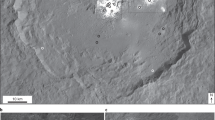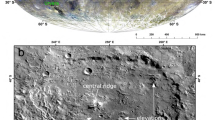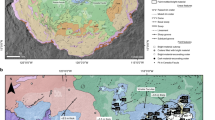Abstract
Ceres, the only dwarf planet in the inner Solar System, appears to be a relict ocean world. Data collected by NASA’s Dawn spacecraft provided evidence that global aqueous alteration within Ceres resulted in a chemically evolved body that remains volatile-rich1. Recent emplacement of bright deposits sourced from brines attests to Ceres being a persistently geologically active world2,3, but the surprising longevity of this activity at the 92-km Occator crater has yet to be explained. Here, we use new high-resolution Dawn gravity data to study the subsurface architecture of the region surrounding Occator crater, which hosts extensive young bright carbonate deposits (faculae). Gravity data and thermal modelling imply an extensive deep brine reservoir beneath Occator, which we argue could have been mobilized by the heating and deep fracturing associated with the Occator impact, leading to long-lived extrusion of brines and formation of the faculae. Moreover, we find that pre-existing tectonic cracks may provide pathways for deep brines to migrate within the crust, extending the regions affected by impacts and creating compositional heterogeneity. The long-lived hydrological system resulting from the impact might also occur for large impacts in icy moons, with implications for creation of transient habitable niches over time.
This is a preview of subscription content, access via your institution
Access options
Access Nature and 54 other Nature Portfolio journals
Get Nature+, our best-value online-access subscription
$29.99 / 30 days
cancel any time
Subscribe to this journal
Receive 12 digital issues and online access to articles
$119.00 per year
only $9.92 per issue
Buy this article
- Purchase on SpringerLink
- Instant access to full article PDF
Prices may be subject to local taxes which are calculated during checkout




Similar content being viewed by others
Data availability
The data that support the plots within this paper, and conclusions of this study are available from the PDS Small Bodies Node website (https://sbn.psi.edu/pds/resource/dawn) or from the corresponding author upon reasonable request.
References
Ammannito, E. et al. Distribution of ammoniated magnesium phyllosilicates on Ceres. Science 353, aaf4279 (2016).
Nathues, A. et al. Recent cryovolcanic activity at Occator crater on Ceres. Nat. Astron. https://doi.org/10.1038/s41550-020-1146-8 (2020).
De Sanctis, M. C. et al. Bright carbonate deposits as evidence of aqueous alteration on (1) Ceres. Nature 536, 54–57 (2016).
Park, R. S. et al. Interior structure of dwarf planet Ceres from measured gravity and shape. Nature 537, 515–517 (2016).
Prettyman, T. H. et al. Extensive water ice within Ceres’ aqueously altered regolith: evidence from nuclear spectroscopy. Science 355, 55–59 (2017).
Williams, D. A. et al. Introduction: the geologic mapping of Ceres. Icarus 316, 1–13 (2018).
Stein, N. T. et al. The formation and evolution of bright spots on Ceres. Icarus 320, 188–201 (2017).
Carrozzo, F. G. et al. Nature, formation, and distribution of carbonates on Ceres. Sci. Adv. 4, e1701645 (2018).
Park, R. S. et al. Evidence of non-uniform crust of Ceres from Dawn’s high-resolution gravity data. Nat. Astron. https://doi.org/10.1038/s41550-020-1019-1 (2020).
Scully, J. E. C. et al. Formation of the bright faculae in Ceres’ Occator crater via long-lived brine effusion in a hydrothermal system. Nat. Commun. https://doi.org/10.1038/s41467-020-15973-8 (2020).
Schenk, P. et al. Impact heat driven volatile redistribution at Occator, Ceres, as a comparative process. Nat. Commun. https://doi.org/10.1038/s41467-020-17184-7 (2020).
Buczkowski, D. L. et al. The geomorphology of Ceres. Science 353, aaf4332 (2016).
Ermakov, A. I. et al. Constraints on Ceres’ internal structure and evolution from its shape and gravity measured by the Dawn spacecraft. J. Geophys. Res. 122, 2267–2293 (2017).
Buczkowski, D. L. et al. The geology of the Occator quadrangle of dwarf planet Ceres: floor-fractured craters and other geomorphic evidence of cryomagmatism. Icarus 316, 128–139 (2018).
Scully, J. E. C. et al. Ceres’ Occator crater and its faculae explored through geologic mapping. Icarus 320, 7–23 (2018).
Scully, J. E. C. et al. Evidence for the interior evolution of Ceres from geologic analysis of fractures. Geophys. Res. Lett. 44, 9564–9572 (2017).
Sizemore, H. et al. A global inventory of ice-related morphological features on dwarf planet Ceres: implications for the evolution and current state of the cryosphere. J. Geophys. Res. 124, 1650–1689 (2019).
Sori, M. M. et al. The vanishing cryovolcanoes of Ceres. Geophys. Res. Lett. 44, 1243–1250 (2017).
Ruesch, O. et al. Cryovolcanism on Ceres. Science 353, aaf4286 (2016).
Quick, L. et al. A possible brine reservoir below Occator crater: thermal and compositional evolution and formation of the Cerealia Dome and Vinalia Faculae. Icarus 320, 119–135 (2019).
Bland, M. T. et al. Dome formation on Ceres by solid-state flow analogous to terrestrial salt tectonics. Nat. Geosci. 12, 797–801 (2018).
Ruesch, O. et al. Slurry extrusion on Ceres from a convective mud-bearing mantle. Nat. Geosci. 12, 505–509 (2019).
Castillo-Rogez, J. C. et al. Conditions for the preservations of brines inside Ceres. Geophys. Res. Lett. 46, 1963–1972 (2019).
Travis, B. J., Bland, P. A., Feldman, W. C. & Sykes, M. V. Hydrothermal dynamics in a CM-based model of Ceres. Meteorit. Planet. Sci. 53, 2008–2032 (2018).
Bowling, T. J. et al. Post-impact thermal structure and cooling timescales of Occator crater on asteroid 1 Ceres. Icarus 320, 110–118 (2019).
Hesse, M. & Castillo-Rogez, J. C. Conditions for the long-term preservation of a local brine reservoir below Occator crater on Ceres. Geophys. Res. Lett. 46, 1213–1221 (2018).
De Sanctis, M. C. et al. Recent emplacement of hydrated sodium chloride on Ceres from ascending salty fluids. Nat. Astron. https://doi.org/10.1038/s41550-020-1138-8 (2020).
Castillo-Rogez, J. C. et al. Ceres: astrobiological target and possible ocean world. Astrobiology 20, 269–291 (2020).
Neveu, M. & Desch, S. J. Geochemistry, thermal evolution, and cryovolcanism on Ceres with a muddy ice mantle. Geophys. Res. Lett. 42, 10197–10206 (2015).
Fagents, S. A. Considerations for effusive cryovolcanism on Europa: the post Galileo perspective. J. Geophys. Res. 108, 5139–5158 (2003).
Schenk, P. et al. The central pit and dome at Cerealia Facula bright deposit and floor deposits in Occator crater, Ceres: morphology, comparisons and formation. Icarus 320, 159–187 (2018).
Raponi, A. et al. Mineralogy of Occator crater on Ceres and insight into its evolution from the properties of carbonates, phyllosilicates, and chlorides. Icarus 320, 83–96 (2019).
Konopliv, A. S. et al. The Ceres gravity field, spin pole, rotation period and orbit from the Dawn radiometric tracking and optical data. Icarus 299, 411–429 (2018).
Park, R. S. et al. High-resolution shape model of Ceres from stereophotoclinometry using Dawn imaging data. Icarus 319, 812–827 (2019).
Fu, R. R. et al. The interior structure of Ceres as revealed by surface topography. Earth Planet. Sci. Lett. 476, 153–164 (2017).
Hager, B. H. & Clayton, R. W. in Mantle Convection: Plate Tectonics and Global Dynamics. The Fluid Mechanics of Astrophysics and Geophysics Vol. 4, 657–763 (Gordon and Breach Science Publishers, 1989).
Hemingway, D. J. & Matsuyama, I. Isostatic equilibrium in spherical coordinates and implications for crustal thickness on the Moon, Mars, Enceladus, and elsewhere. Geophys. Res. Lett. 44, 7695–7705 (2017).
Konopliv, A. S., Banerdt, W. B. & Sjogren, W. L. Venus gravity: 180th degree and order model. Icarus 139, 3–18 (1999).
MacKay, D. J. C. Information Theory, Inference and Learning Algorithms (Cambridge Univ. Press, 2003).
Gregory, P. Bayesian Logical Data Analysis for the Physical Sciences: A Comparative Approach with Mathematica® Support (Cambridge University Press, 2005).
MacMillan, W. D. The Theory of the Potential (Dover Publications, 1930).
Goodman, J. & Weare, J. Ensemble samplers with affine invariance. Commun. Appl. Math. Computat. Sci. 5, 65–80 (2010).
Collins, G. S., Melosh, H. J. & Ivanov, B. A. Modeling damage and deformation in impact simulations. Meteorit. Planet. Sci. 39, 217–231 (2004).
Wünnemann, K., Collins, G. S. & Melosh, H. J. A strain-based porosity model for use in hydrocode simulations of impacts and implications for transient crater growth in porous targets. Icarus 180, 514–527 (2006).
Marchi, S. et al. The missing last impact craters on Ceres. Nat. Commun. 7, 12257 (2016).
Castillo-Rogez, J. C. et al. Insights into Ceres’ evolution from surface composition. Meteorit. Planet. Sci. 53, 1820–1843 (2018).
Acknowledgements
This research was carried out in part at the Jet Propulsion Laboratory, California Institute of Technology, under a contract with the National Aeronautics and Space Administration. We thank the Dawn operations team for the development, cruise, orbital insertion and operations of the Dawn spacecraft at Ceres. M.A.H. was supported by National Science Foundation (NSF) grant DMS-1720349. US Government sponsorship is acknowledged.
Author information
Authors and Affiliations
Contributions
C.A.R. led the preparation of the manuscript and the geophysical data analysis and interpretation with A.I.E. (MCMC modelling), J.C.C.-R. and M.A.H (thermal modelling), and S.M. and B.C.J. (scaled iSALE results). J.E.C.S. analysed dome morphology, D.L.B., H.G.S. and P.M.S. contributed to geomorphologic interpretation and J.T.K. illustrated the evolution scenario. A.N., R.S.P., T.H.P., L.C.Q., M.D.R. and C.T.R. contributed to the preparation of the manuscript.
Corresponding author
Ethics declarations
Competing interests
The authors declare no competing interests.
Additional information
Peer review information Nature Astronomy thanks Douglas Hemingway and the other, anonymous, reviewer(s) for their contribution to the peer review of this work.
Publisher’s note Springer Nature remains neutral with regard to jurisdictional claims in published maps and institutional affiliations.
Extended data
Extended Data Fig. 1 Isostatic gravity anomaly for degrees n=1 to local degree strength4 including XM2 high-resolution data.
The outline of Hanami Planum in white dashed curve.
Extended Data Fig. 2 Degree strength and isostatic anomaly maps through Hanami Planum.
The degree strength (left plot) is overplotted over the isostatic anomaly in the right panel. Degree strength equals 20, 30 and 40 for the blue, green and red contours, respectively.
Extended Data Fig. 3 Posterior distributions resulting from MCMC modeling of gravity field from n=1 to local degree strength beneath Hanami planum.
Top: Longitude (λ), latitude (ϕ) and total mass deficit (M) are well-constrained. Bottom: Source aspect ratio (i.e., ratio of horizontal ellipsoid semi-axis a to the vertical semi-axis c), depth to source (Ztop) and density contrast (Δρ) show broader probable ranges. The 2.5 – 97.5 % confidence intervals are shown on the top of each histogram.
Extended Data Fig. 4 Posterior distribution resulting from MCMC modeling of gravity field from n=1 to local degree strength beneath the Occator crater region.
The average field in an annulus between 20 and 30 degrees from the center of anomaly A was removed to suppress the large long-wavelength negative isostatic anomaly before the inversion was performed. Top: longitude (λ), latitude (ϕ) and total mass deficit (M) are well-constrained. Bottom: Source aspect ratio (i.e., ratio of horizontal ellipsoid semi-axis a to the vertical semi-axis c), depth to source (Ztop) and density contrast (Δρ) show broader probable ranges. The 2.5 – 97.5 % confidence intervals are shown on the top of each histogram.
Extended Data Fig. 5 Effect of the impact on the region predicted by hydrocode model.
Maps of post-impact temperature field a, and damage b, with depth. Temperature field was scaled from iSALE hydrocode modelling by25 using updated thermal evolution models that reflect the current understanding based on Dawn data23 (See Methods). The damage region plot is from the modeling of25. Intact material has a damage parameter, D=0, while thoroughly fractured material has D=143.
Extended Data Fig. 6 Thermal model for the Hanami planum region assuming a thermal gradient of 2.73 K/km.
The solid black line at ~420 km indicates the boundary between the ice- and hydrate-rich crust (above) and the rocky mantle (below). See Methods for details.
Extended Data Table 1 Results of MCMC modelling.
The median values are given with 2.5th to 97.5th percentile ranges.
Extended Data Table 2 Bounds on the model parameters for the Hanami Planum MCMC runs.
Lower and upper bounds are given for the semiaxes’ lengths, central depth and density contrast of the anomolous ellipsoid. Note that the geographic coordinates of the center of the anomaly were constrained to be within a 5° small circle of the specificed location. In addition, the top point on the vertical ellpsoid axis was constrained to be the shallowest point of the anomalous ellipsoid.
Extended Data Table 3 Bounds on the model parameters for the Occator SE MCMC runs.
Lower and upper bounds are given for the semiaxes’ lengths, central depth and density contrast of the anomolous ellipsoid. Note that the geographic coordinates of the center of the anomaly were constrained to be within a 5° small circle of the specificed location. In addition, the top point on the vertical ellpsoid axis was constrained to be the shallowest point of the anomalous ellipsoid.
Extended Data Table 4 The model parameters for the Hanami Planum and Occator SE representative models shown in Figure 2.
These model parameters represent the median values and do not correspond to the maximum-likelihood solution.
Rights and permissions
About this article
Cite this article
Raymond, C.A., Ermakov, A.I., Castillo-Rogez, J.C. et al. Impact-driven mobilization of deep crustal brines on dwarf planet Ceres. Nat Astron 4, 741–747 (2020). https://doi.org/10.1038/s41550-020-1168-2
Received:
Accepted:
Published:
Issue Date:
DOI: https://doi.org/10.1038/s41550-020-1168-2
This article is cited by
-
An ancient and impure frozen ocean on Ceres implied by its ice-rich crust
Nature Astronomy (2024)
-
Sustained and comparative habitability beyond Earth
Nature Astronomy (2023)
-
Volcanism in the Solar System
Science China Earth Sciences (2023)
-
Brine residues and organics in the Urvara basin on Ceres
Nature Communications (2022)
-
The Diverse Planetary Ingassing/Outgassing Paths Produced over Billions of Years of Magmatic Activity
Space Science Reviews (2021)




